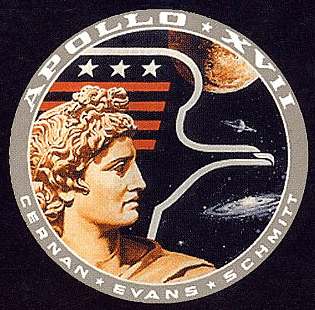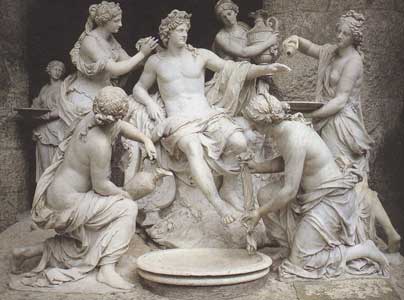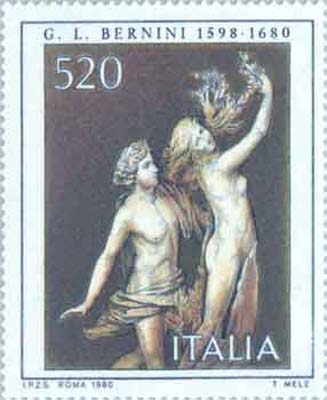.
He is the very embodiment of the Hellenic spirit. Everything that marks off the Greek outlook from that of other peoples, and in particular from the barbarians who surrounded them—beauty of every sort, whether of art, music, poetry or youth, sanity and moderation—are all summed up in Apollo. W.K. Guthrie, The Greeks and Their Gods



Apollo Belvedere Pio-Clementino Inv1015
Apollo Belvedere a masterpiece of Greek Art. A copy of a work probably of the Athenian artist Leochares, around 320 BC, who worked for Alexander the Great" (Havelock. Hellenistic Art. New York Graphic Society: Greenwich, Conn., 1970; 124). The statue of Apollo wearing a Chlamys was discovered in the late 1400's near Rome. It has been in the Vatican since 1511 and is shown at the Cortile del Belvedere from which it gets its name. It had a major influence of the Renaissance Arts such as in David and the Creation of Adam. Like in different pottery images the hair style attenuates the female character of Apollo, at least I have this impression. Where is his Lyra, the instrument which he always carries?
The serpent creeping up the tree is a symbol of the powers of darkness vanguished by the god. It may also be taken as the symbol of life and healing, like the serpent of Asclepius. The Mythology of Greece and Rome

Apollo Belvedere on the Apollo 17 mission patch (the last and most successful mission to the Moon in December 1972)
Apollo Belvedere censored and with added hands
The pubic area censored by a leaf , Without a cover
Is the Apollo Belvedere more perfect than necessary? Artists “experts” have different opinions and “taste” changes with time:
'The highest ideal of art ... An eternal spring, as in the happy fields of Elysium clothes with the charms of youth the graceful manliness of ripened years, and plays with softness and tenderness about the proud shape of his limbs. J. J. Winckelmann, History of Ancient Art.
There is great softness, sweetness, symmetry, and timid grace - a faultless tameness, a negative perfection. ... The Apollo Belvedere is positively bad, a theatrical coxcomb, and ill-made: I mean compared with the Theseus (Now identified as Dionysus, part of the east pediment of the Parthenon) W. Hazlitt, Notes of a Journey through France and Italy (in The Complete Works of William Hazlitt Vol. X, edited R. Howe after the edition of A. R.Waller and Arnold Glover, Centenary Edition, London: Dent, 1930)
His figure is slender, according to the fashion which prevailed from the middle of the fourth century onward, and he moves over the ground with marvelous lightness. His appearance has an effect of almost dandified elegance, and critics to-day cannot feel the reverent raptures which this statue used to evoke. Yet still the Apollo of the Belvedere remains a radiant apparition. F. B. Tarbell, A History Of Greek Art




Abraham Bosse, »Représentations de diverses Figvres hvmaines, avec leurs mesures prises sur des antiqués.« Paris 1656 , an analysis of the proportions of the Apollo Belvedere or François Anne David, »Elémens du Dessin ou Proportions des plus belles figures de l'antiquité, à l'usage de ceux qui se destinant aux Beaux Arts.«, Paris 1798

Apollo Belvedere was probably a model for many other works one such example I guess from the similarities is Apollo and the Nymphs by Francois Girardon (1628 Troyes - 1715 Paris)

Apollo and Daphne, Gian Lorenzo Bernini. Apollo Belvedere probably used as a model.


The Internal Anatomy of Apollo Belvedere by a French anatomist in the Napoleonic Period.


Apollo Belvedere Stamps from the Vatican,


Nigeria and fom Paraguay (from Latein Education Highway, Austria)
| Ancient Greece
Science, Technology , Medicine , Warfare, , Biographies , Life , Cities/Places/Maps , Arts , Literature , Philosophy ,Olympics, Mythology , History , Images Medieval Greece / Byzantine Empire Science, Technology, Arts, , Warfare , Literature, Biographies, Icons, History Modern Greece Cities, Islands, Regions, Fauna/Flora ,Biographies , History , Warfare, Science/Technology, Literature, Music , Arts , Film/Actors , Sport , Fashion --- |

